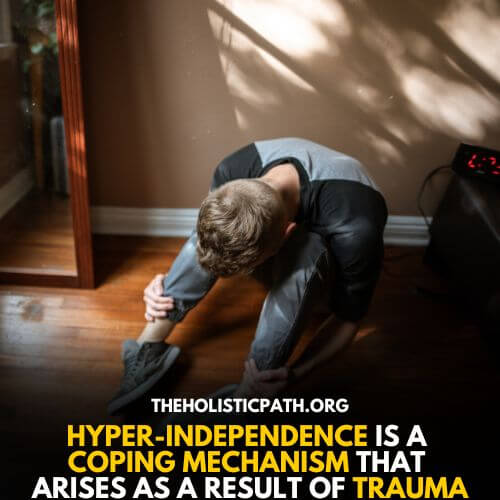Independence is a cornerstone of adulthood, with each of us striving to stand on our own two feet, handle our responsibilities, and create a safe, autonomous environment. However, like anything taken to an extreme, this virtue can sometimes turn into a vice.
The term at hand? Hyper-independence.
Just as every hero faces a challenge too great to conquer alone, and every traveler needs a helping hand now and then, the same goes for us. In this article, we’re going to unpack the concept of hyper-independence and why, at times, it might not be the golden ticket we think it is. So, grab your reading glasses and get ready for a journey into the world of excessive self-reliance.
What Is Hyper-Independence?
Hyper-independence, also known as extreme self-reliance, entails an excessive rejection of external help or support. While independence is generally positive, hyper-independence goes to unhealthy extremes. It’s crucial to grasp that it’s not just about self-sufficiency but involves rigidly refusing assistance even when necessary.
People with hyper-independence believe they must handle everything alone, regardless of the situation.
This mindset leads them to resist seeking advice or support, even when collaboration would be generally helpful. Hyper-independent individuals may fear vulnerability or dependence, often stemming from past trauma or trauma history.
In fact, understanding what hyper-independence is can be quite helpful. This extreme self-reliance can hinder personal growth and well-being, as it limits one’s ability to benefit from the assistance of others.
Hyper-Independence: 10 Signs & Symptoms
Hyper-independence can manifest differently in individuals, but there are common signs and symptoms associated with this condition. Understanding these signs is crucial, as it can help individuals, as well as their friends and family, recognize when hyper-independence is becoming problematic. Additionally, it is helpful to consider how past trauma and trauma history may contribute to the development of hyper-independence.
Signs and Symptoms of Hyper-Independence:
| Sign/Symptom | Description |
|---|---|
| 1. Reluctance to Seek Help | A marked reluctance to seek assistance or support from others, even when it is generally considered appropriate. |
| 2. Excessive Self-Reliance | Taking on an excessive amount of responsibility, rarely delegating tasks or accepting assistance, which can lead to burnout. |
| 3. Difficulty in Trusting Others | A general wariness of relying on others for support or assistance, often stemming from past trauma or negative experiences. |
| 4. Resistance to Collaboration | Preferring to work alone and resisting collaboration, even when it could lead to more effective and efficient outcomes. |
| 5. Fear of Vulnerability | A fear of being perceived as weak or dependent on others is often rooted in past trauma or being let down by trusted individuals. |
| 6. Avoidance of Emotional Connections | Avoiding deep emotional connections to maintain self-reliance, potentially leads to loneliness and isolation. |
| 7. Perfectionism | Setting very high standards and being a perfectionist, feeling that only they can meet their own expectations, increasing self-reliance. |
| 8. Difficulty in Receiving Feedback | They find it challenging to accept constructive criticism, perceiving it as an attack on their competence and rejecting it. |
| 9. Avoidance of Asking for Advice | Even when facing complex decisions, they avoid seeking advice and prefer to figure things out on their own, potentially leading to suboptimal decision-making. |
| 10. Strained Relationships | Straining relationships with friends and family due to a need for self-reliance may come across as indifference or a lack of trust in others’ capabilities. |
6 Ways Hyper-Independence Is a Trauma Response
Yes, hyper-independence is a trauma response. Trauma is a complex psychological and emotional response to distressing events, often leading individuals to develop coping mechanisms to survive and adapt.
Hyper-independence is one such coping mechanism that arises as a result of trauma. It manifests as an excessive and rigid need for self-reliance and avoidance of emotional or relational dependence on others. This response can be understood through several key elements:
1. Loss of Trust and Safety:
Trauma often involves a breach of trust and a profound sense of vulnerability. When individuals experience interpersonal trauma or situations that disrupt their perception of safety and trust, they may find it challenging to rely on others. These experiences can lead to a fundamental loss of trust in people and the world.
Consequently, individuals develop hyper-independence as a defense mechanism to protect themselves from potential harm.
This defense mechanism involves distancing from others, relying on self-sufficiency, and avoiding dependence on anyone else. It’s a way of safeguarding oneself against the perceived risks of trusting others, given that past experiences have shown that trust can be broken.

2. Emotional Avoidance:
Trauma often instills a deep fear of vulnerability and emotional expression. The perceived risks associated with opening up and trusting others can be overwhelming for trauma survivors. As a result, they may learn to suppress their emotions and avoid seeking emotional support from others.
This emotional avoidance is a key aspect of hyper-independence.
Trauma survivors opt for a self-contained and emotionally distant approach to life as a way to cope with their fears and anxieties related to emotional expression and vulnerability. They might believe that emotional distance and self-reliance provide a shield against further emotional harm.
3. Control and Safety:
Traumatic situations frequently strip individuals of their sense of control over their environment and personal safety. In response to this perceived lack of control, hyper-independence emerges as an attempt to regain a sense of control and safety. By relying exclusively on themselves, individuals can create an environment where they feel safe and can predict outcomes.
This self-reliant approach reduces the chances of being hurt again, as they can manage their surroundings and personal safety to a high degree. It’s an adaptive response to regain a sense of security in an unpredictable world.
4. Dissociation and Disconnection:
Trauma can lead to a psychological defense mechanism known as dissociation, where individuals disconnect from their emotions and bodily sensations to cope with overwhelming experiences. Hyper-independence is a form of emotional dissociation in which individuals detach from their own needs and emotions.
Instead, they rely on rationality and self-sufficiency to navigate life.
This emotional disconnect helps manage the intense emotional burden that trauma often brings. By suppressing their emotional responses and prioritizing rationality and self-reliance, they create a buffer against the emotional pain and turmoil associated with their traumatic experiences.
5. Avoiding Vulnerability
In a trauma response, the vulnerability that comes with depending on others can feel threatening. Depending on others can feel threatening because it involves opening oneself up to the possibility of being hurt again.
Hyper-independence is a way to shield oneself from this vulnerability. It allows individuals to maintain a facade of strength and self-sufficiency, making them less susceptible to being hurt by others.
6. Underlying Fear and Anxiety
Trauma can leave a lasting imprint of fear and anxiety in individuals. They become hypervigilant about their surroundings and relationships, constantly on guard for potential threats. Hyper-independence can be a way to manage this anxiety by controlling one’s own life and distancing from situations that might trigger traumatic memories or emotions.
This control and distance are strategies to cope with the underlying fear and anxiety that trauma has instilled, even though they may isolate the person from potentially supportive relationships and hinder their emotional healing.
5 Other Common Causes of Hypey-Independence
While trauma is a significant factor for hyper-independence in an individual, there are several other common causes that can contribute to hyper-independence. Here are 5 of the other causes for hyper-independence:
-
Overprotective Parenting: Overprotective or helicopter parenting can foster hyper-independence in children. When parents excessively shelter their children from challenges or problem-solving, the child may not learn to rely on themselves or develop the necessary skills for independence. They become overly self-reliant as a coping mechanism for a lack of trust in others or fear of incompetence.
-
Perfectionism: Perfectionism is a personality trait characterized by setting unrealistically high standards for oneself. Individuals with perfectionist tendencies may become hyper-independent because they believe no one else can meet their standards. They fear that relying on others will result in errors or disappointment, leading them to take on all responsibilities themselves.
-
Attachment Style: Attachment theory posits that early experiences with caregivers can shape one’s attachment style. Those who develop an avoidant attachment style may struggle with intimacy and emotional dependence. They may become overly independent as a defense mechanism against the vulnerability and potential rejection associated with relying on others for emotional support.
-
Cultural and Societal Influences: Cultural and societal factors can contribute to hyper-independence. In some cultures, there is a strong emphasis on individualism and self-reliance, which may discourage seeking help or relying on others. Societal messages that prioritize personal achievement and autonomy can lead individuals to overvalue independence to the detriment of healthy interdependence.
-
Previous Negative Interactions: Negative past experiences in relationships, such as betrayal, abandonment, or exploitation, can lead to hyper-independence. People who have been hurt or let down by others may develop a defensive stance, believing that they can only rely on themselves to avoid future pain. They may avoid forming close bonds or asking for help to protect themselves from further emotional harm.
What Makes a Woman Hyper-Independent?
Hyper-independency in women can result from a combination of social, psychological, and personal factors. These can include:
-
Cultural and societal expectations: Women may feel pressure to be self-reliant and independent due to evolving gender roles and expectations. This can lead some women to overcompensate and become hyper-independent.
-
Past experiences: Traumatic or challenging life experiences, such as being let down or betrayed by others, can lead women to develop a heightened sense of independence as a defense mechanism.
-
Personality traits: Some individuals have inherent personality traits that make them more inclined toward independence. These traits may be more pronounced in some women, leading to hyper-independency.
-
Fear of vulnerability: A fear of vulnerability or dependence on others can drive hyper-independency. This fear may stem from past relationships or emotional experiences.
-
Self-esteem issues: Low self-esteem or a desire to prove oneself can lead to hyper-independency as women may feel the need to demonstrate their capabilities and worth.
It’s important to note that hyper-independency, like any behavior, exists on a spectrum, and not all independent women will exhibit this to an extreme degree. Balancing independence with healthy interpersonal relationships is key to overall well-being.
Example of Hyper-Independence in Women: Gabrielle Union
A notable example of hyper-independence is actress Gabrielle Union, as highlighted in an Essence article. Union and her husband, Dwyane Wade, reportedly split their household bills evenly. This choice to maintain strict financial equality in their relationship may reflect certain aspects of hyper-independence.
In Gabrielle Union’s case, this behavior could be influenced by her life experiences, including possible trauma (poverty trauma) or trust issues, which can be associated with her husband’s past actions. This example underscores the complexity of hyper-independence in women and how it can manifest in various aspects of life, including financial decisions within a relationship.
13 Treatments and Strategies for Dealing With Hyper-Independence
Hyper-independence can be challenging to overcome, but with the right support and strategies, it is possible to find a healthier balance between independence and interdependence. Here are some treatments and strategies to address hyper-independence:
-
Self-awareness and Acceptance: The first step is recognizing that hyper-independence may be causing problems in your life. Acknowledging and accepting this trait is crucial for initiating change.
-
Therapy: Consider individual therapy with a psychologist or counselor who can help you explore the root causes of your hyper-independence. They can assist you in identifying the underlying issues and work on strategies to become more open to support and connection.
-
Group Therapy: Group therapy can be particularly effective for individuals with hyper-independence. It provides a safe and supportive environment to practice being more open and vulnerable with others.
-
Mindfulness and Relaxation Techniques: Practicing mindfulness meditation and relaxation exercises can help reduce anxiety and stress associated with hyper-independence. This can create a more balanced approach to self-reliance.
-
Social Skills Training: Learning and practicing social skills, such as active listening, empathy, and effective communication, can help you build and maintain healthy relationships.
-
Set Realistic Boundaries: It’s important to learn how to set boundaries and recognize when it’s appropriate to ask for help. This can involve establishing a balance between independence and interdependence.
-
Seek Support: Reach out to trusted friends or family members and let them know about your efforts to change. They can provide support and encouragement, and you can practice seeking help from them in a controlled and supportive environment.
-
Gradual Exposure: Start small by seeking assistance or input in low-stakes situations. As you become more comfortable with this, gradually challenge yourself to seek support in more significant aspects of your life.
-
Cognitive Behavioral Therapy (CBT): CBT can help you identify and change negative thought patterns and beliefs that may contribute to hyper-independence. This type of therapy can promote a healthier perspective on self-reliance and interdependence.
-
Goal Setting: Set specific goals for yourself in terms of becoming more open to support and collaboration. Track your progress and celebrate your successes along the way.
-
Self-Compassion: Be kind and understanding toward yourself. Acknowledge that everyone needs support and that seeking help is a sign of strength, not weakness.
-
Role Models: Identify people in your life who exhibit a healthy level of independence and interdependence. Learn from their behaviors and seek guidance from them.
-
Trauma-Informed Therapy: Seek a therapist or counselor who specializes in trauma-informed therapy. This approach recognizes the impact of trauma on a person’s life and can help individuals with PTSD develop a more balanced approach to independence and interdependence.
Conclusion
While hyper-independence may offer a sense of self-reliance and autonomy, it also carries the risk of isolating individuals from valuable social connections and support networks. Recognizing the delicate balance between independence and interdependence is crucial in navigating the challenges posed by hyper-independence. Finding a middle ground that promotes self-sufficiency while also fostering meaningful relationships and community bonds is key to achieving a more balanced and fulfilling life.
References
Uwumarogie, V. (2023, May 19). Some people think Gabrielle Union is exhibiting toxic independence. What does that mean? Essence. https://www.essence.com/lifestyle/toxic-independence/


